Keir Leslie – 31 January, 2013
In the end, the most fun I had with Youle's work was by putting heaps of spheres in at the start, and watching them rattle, bounce and run off each other, and onto and across the floor, evading the finality Youle seems determined to marshal them into. For all the forced, tiresome jollity of Youle's work, it feels humourless.
Rolling Maul program at NG
Matt Akehurst, Rob Hood, and Wayne Youle
Tricksters
22 December 2012 - 27 January 2013
You hear Youle’s work first, as you come up the steps, the racket of maple on pine. It’s a clattering, insistent noise, that being probably the most interesting thing about Youle’s work - a large set of wooden channels, arranged on one wall in such a way that a wooden ball may be dropped at the top and roll to the bottom. Once you realise that the system is entirely deterministic, that a given ball will always end in one bucket or the other, it becomes quite hard to see the point. If you are interested in coin zig-zags, the local fish and chip shop will almost certainly have a better one. (Possibly, amusingly, it will have one designed for older, larger coins, and there may be a resultant frission of interest in introducing a smaller coinage into the system.)
In the end, the most fun I had with Youle’s work was by putting heaps of spheres in at the start, and watching them rattle, bounce and run off each other, and onto and across the floor, evading the finality Youle seems determined to marshal them into. For all the forced, tiresome jollity of Youle’s work, it feels humourless.
Rob Hood presents a large wooden cabinet, placed facing the entrance at an angle to the wall. Behind, a large sheet of black plastic billows out, covering its back, filling the space between the furniture and the wall. It’s an attractive formal device, a trailing bustle behind the stately cabinetry. On the shelves are placed various objects: a gold cone, some tat, a few cups, a collection of books, some vinyl records. It’s also a device that recalls his presentation of the Fomison library at Prospect. The books - Ballard, Lovecraft, the occult, some encyclopedic texts - and the records - Nick Cave, Joy Division, Sonic Youth - present an image of the artist as obsessed with the hidden, the secret history, distortion. It could be read as a self-portrait, or a vanitas.
There are also some simulcra plaster bricks, manufactured by Hood. The plaster bricks, presented on the floor, begin to feel redundant in this context. A reading through to Carl Andre is opened up, but it doesn’t really go far enough. The nicest play is between Hood’s fake brick propping the gallery door open (possible a nice call-out to Gentry’s foot in the door?) and the neighbouring architects’ real stone slab. Cutely, the architects next door are called Nott, the negation echoing Hood’s concerns.
Matt Akehurst’s work is the quietest in the show. A series of small, polished white blobs sit on the rafters, peering down at the space. In some ways they are almost twee, given their anthropomorphisation, scale, and polish. In other ways, they take on an eerie, Lovecraftian role, as Andrew Paul Wood argued in his review of Akehurst’s show Object. This Lovecraftian, pulp-horror reading is amplified by Hood’s choice of literature.
His command of the formal vocabulary of modernist biomorphism is, by this point, convincing. It may be this formal control that has allowed Akehurst to dispense with the plinth and crutches, and place his blobs straight into the gallery space. This move pushes the work into a more direct confrontation with the space, and pulls it somewhat away from the historicising irony of much of his previous work.
Hood’s and Akehurst’s work plays well together, bouncing ironies and horror, references and quotations off each other. Youle’s work seems isolated and shallow by comparison.
Keir Leslie
Recent Comments
Creon Upton
I'm sure Marcel's corpse is endlessly delighted at getting to witness first-hand the enduring profundity of that blessed fountain. The ...
Roger Boyce
I wonder, does Duchamp's well-exercised corpse ever gets weary of being dragged, by critical noose, from its sarcophagus and stood ...
John Hurrell
Yes Keir, it's interesting to bring Duchamp into this notion of Trickster, because unlike say Rob Hood and his bricks, ...
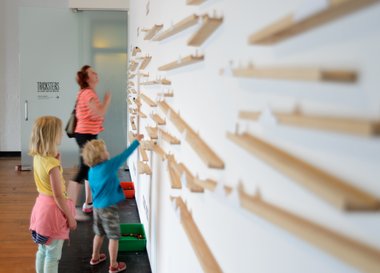
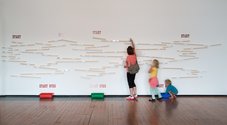
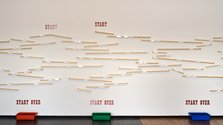


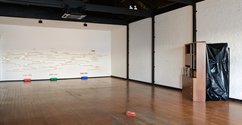
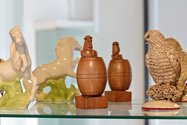


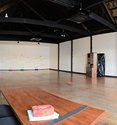
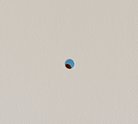

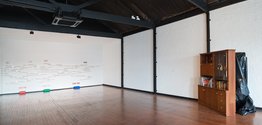
 Advertising in this column
Advertising in this column Two Rooms presents a program of residencies and projects
Two Rooms presents a program of residencies and projects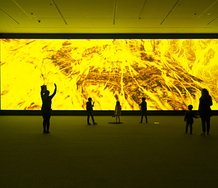

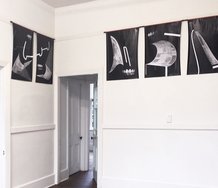
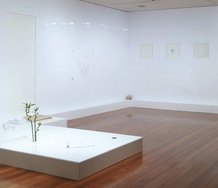
This Discussion has 9 comments.
Comment
John Hurrell, 12:30 a.m. 1 February, 2013 #
I assume this show links these artists to tricksters, as discusssed by authors like Lewis Hyde, and typified by artists like say Andreas Slominski, whose projects really push the capabilities of the institution through their outrageous, unpredictable and difficult demands.
Creon Upton, 6:58 p.m. 2 February, 2013 #
Nice reviewing, KL.
Interesting though: When I look at the Youle images, especially with that wholesome family participation, I can't help but see your comments in terms of the "Start" and "Start over" signs. Is it possible that the artist is presenting some (none-too-subtle) allegory of the crude determinism that rules over what passes for lives tolerably lived, generation in, generation out?
Is he being sardonic?
That said, I sympathise with your take, only because Youle seems to many a bitter Christchurch eye (I believe), since that big shadow-wall thing, a by-word for this compulsory feel-good, empty nostalgia, imagining that by the sheer force of general goodwill the masters of control and the forces of inertia may be kept silently at bay.
And who buys that?
Also: The Akehurst numbers look almost like pasty Tralfamadorians. Sentinels over time. Onlookers detached from care.
And Hood: Nick Cave, Joy Division, Sonic Youth? That's some pretty good desert island s#1t right there, no?
John Hurrell, 1:27 a.m. 3 February, 2013 #
Creon, I bet you, like me, like almost all EyeContact readers, were raised within a 'wholesome family'. So by 'crude determinism' are you thinking of some kind of bourgeois allegory like that which Daniel Defoe constructed with Robinson Crusoe - a middleclass template for a 'successful' prosperous life?
Roger Boyce, 7:11 p.m. 3 February, 2013 #
Part 1
Full disclosure:
I do not come from a “wholesome family”.
I share a gallery affiliation with Wayne Youle.
And I lecture at the same art school the reviewer recently graduated from.
Inclination to earnestly prospect for the ( R )eal meaning is a passing fancy and a rarely fatal affliction of youth. It can manifest as cavalier overconfidence in one’s innate (or precociously learned) ability to reliably and rationally suss a thing’s classifiable properties. And from such, typologically ‘understood’ characteristics sort one thing from another (as in accountancy and assay offices) to critically define and arrive at the (big T) truth or falsity of the thing-in -question.
In other words, to sort value from dross, as does the seasoned prospector confidently differentiate honest gold from pyrite’s seductive misdirection.
The problem with artworks – at least since the creative invention of unreliable narrators – is that they, more often than not, derive imaginative purchase and affective mechanism from their very slipperiness. From demonstrated ability to slip the restraining grasp of literal, fixed, meaning. A more promising (and useful) metaphor for a critic having a run at ‘reading’ evermore oleaginous and vermicular contemporary artworks would be that of cult-temple priest having a go at auguring from still squirming animal guts.
Someone, anyone, having a-go-at-the-guts, sans temple tenure and initiation, or someone not wishing to dirty their hands with marginally-objective and admittedly savage temple protocols: which, for all intents and purposes, uses beastly innards as some sort of grisly poetic teleprompter. Someone unwilling to stand in the changing and transformative vapors of the work itself and so, instead of entertainingly intoxicated oracular speech we, the readers, are left with Leslie’s clear-eyed, no-nonsense anthropologist (as in Walter Cronkite’s You Are There) voice-over purporting to empirically interpret the work’s True empirical meaning by means of a superior and dispassionate totting up of the sum of its parts. Why it’s nothing but a tiresome pile of guts … well, that’s a relief. Sherry anyone?
Roger Boyce, 7:12 p.m. 3 February, 2013 #
Part 2
Tricksters (in case the exhibition’s title was somehow overlooked by the critic) have a habit of looking like one thing while being another.
Think Br’er Rabbit. Picture the Tar Baby. Imagine taking the Tar Baby for the literal adversary it claimed to be … and then (literally) putting one’s foot in it. As has our tyro reviewer in regard to his echt-literal, echt-earnest disappointment with and misunderstanding of Youle’s TUMBLE, CRUMBLE, MUTTER & MUMBLE. Or maybe Leslie simple-mindedly took the work as a failed ‘interactive’ artwork rather than teasing out the possibly built in (or inferred) critique of artworks, interactivity and interactive-artworks. Or the teasing conceit of human assumption of contributive or participatory part to play when larger forces themselves are at play. By the way, I’m just playing here.
Where Mr. Leslie sees “-forced, tiresome jollity –“ I see a diabolically beguiling invitation to a groundhog-day-like exercise in futility….posed as a positive. An exercise Cantabrians are intimate with – IF I must go all-literal on your asses.
Where Mr. Leslie sees “ - isolated and shallow –“ I see clustered events at various tectonic and psychological depths, as optically and kinetically graphed by the work’s predestined Rube Golberg-like mechanism. A mechanism that devilishly delivers nothing more (and nothing less) than frustrated expectation. Its invitation to start over, nothing more than a textual encouragement to engage in further discouragement. It proffers notions of initiative and free will in an over-and-over ‘world’ designed to deliver the same results. Over and over.
I’ve been following Youle’s practice for some time now. And like most artists with a track record worth looking at he does the same thing over and over - In a multitude of intellectually adroit ways.
In either short-con or long-con fashion Youle makes objects and devices that promise one thing but deliver another. The real problem with Keir Leslie’s take on Youle is that (in his eager ‘mark’s’ greed for a quick intellectual payday) he bought Youle’s glib promise and missed the grim payload’s (the sucker-punchline’s ?) delivery…..altogether. And instead got clobbered.
The best that can be said of Keir Leslie’s writing is that he constructs tight, lucid, highly-readable sentences sans theoretic doggerel.
I’ve little to say about KL’s take on the other two artists’ productions. Artists I have worked with. Suffice it to say to Wayne, Mr. Leslie, EyeContact's publisher, and anyone else that gives a toss … “failed criticism is like skinned knees – painful but rarely fatal.”
Keir Leslie, 1:33 a.m. 4 February, 2013 #
John: I think that Duchamp lurks around here, as a kind of ur-trickster figure in modern art. There's also a tension between the trickster figure and the inherent official-ness of municipal galleries.
Creon: thank you! It's certainly possible Youle intended his work to be read sardonically; but if he did there's just not enough there to cut against the kitsch-y, "straight" reading. And, I found, that even once I supposed it do be sardonic, there wasn't anything extra there that wasn't being put into the work by the assumption of sardonicity, if that makes sense.
Roger: if you compare my writing to Cronkite, and say that "I construct tight, lucid, highly-readable sentences sans theoretic doggerel", then I can only hope that all of my writing is as much of a failure as this!
John Hurrell, 12:27 a.m. 5 February, 2013 #
Yes Keir, it's interesting to bring Duchamp into this notion of Trickster, because unlike say Rob Hood and his bricks, MD doesn't use mimicry or replica to 'trick' his audience. It is a different sort of thinking. If you think about - as an example - Etant Donnes, he mocks voyeurism by deforming the object of desire, making it inaccurate anatomically in order to generate a form of horror. He flips desire around to reverse it.
Roger Boyce, 11:21 a.m. 6 February, 2013 #
I wonder, does Duchamp's well-exercised corpse ever gets weary of being dragged, by critical noose, from its sarcophagus and stood up for every argument?
This sanctified boulevardier was less a genuine trickster (excepting his pseudo-art-retirement phase) than a fellow (like Alfred Barr) who enjoyed nothing so much as the subsidized leisure of 'ladies-who-lunch'. And who underwrote his gamesmanship dabbling in the secondary art market with bored but assiduously art-gentrifying scions.
How this drawing-room pet became the subversive patron saint of self-styled 'post-structure refuseniks is one of life's enduring mysteries. Just as Pollock's piss was essentially sanctified by Peggy Guggenheim's fireplace and (reportedly) bed ... so was Marcel's infamous urinal nothing without its institutional pas de deux.
Now to Mr. Leslie's Alfred E. Neuman-like what, me worry "-I can only hope-".
Hope, as per that trope, is akin to credulous digging, for still-edible sweet-corn kernels, in a fresh dead-drop of unfavorably critical turds.
"highly-readable sentences" (unlike my own self-indulgent self-swallowing prose) is what's longed for (but rarely available) in Chinese manufactured Christmas toy assembly instruction. Good criticism requires a bit of allusive poetry to create the resonant harmonic notes which equip it hum in accord (or discord) with the thing being written of.
That's me, as far as this thread's concerned.
Creon Upton, 1:10 a.m. 7 February, 2013 #
I'm sure Marcel's corpse is endlessly delighted at getting to witness first-hand the enduring profundity of that blessed fountain.
The (rather unhealthy) joke in the room is the thing's institutional legacy. It was, you see darlings, of course worthless in the sense of being the art that it was pretending to be. But as art that was *commenting* on the art that it was pretending to be - well, in that case it is A Work of Very High Value. The innocent urinal was not art, but the ironic one remains art to this day.
And that is why, children, it is so terribly important that art be commenting, and dialoguing, and about. Heaven forfend that it might simply be what it is.
I had the particular pleasure of attending an "artist's talk" recently, listening in pain as a young man told us all about some stuff that he thinks about sometimes. Cool fun. Apparently the idea was to elucidate his work.
Is this what happens at a crit? Is this how the art world develops such a high threshold for finding ways to take drivel seriously? Are we really telling our children that we're interested in what they think about?
Studying English as a young man, I had my thoughts, I put them into essays, and some harried alcoholic read them and handed them back to me along with a few scribbled comments. After a while, the physical presence in my life of said documents would discomfit me enough that I'd send them the way of all things.
Just think. If I'd had the fine arts treatment, I'd have got together with a few mates and set up a publishing company to collate our insights and share them with the world. We'd have hosted monthly book launches and put it all on our CVs. Man, why was I so naive as to think I couldn't possibly be in the least bit interesting?
To my mind, Roger, "highly readable sentences" are a pretty solid grounding for Mr Leslie and one that ought not be undermined. Sending him off in search of allusive poetry and resonant harmonic notes is like asking a 19 year old to reflect on what they're thinking about. It can only lead to harm - and worse, to extreme tedium.
Participate
Register to Participate.
Sign in
Sign in to an existing account.